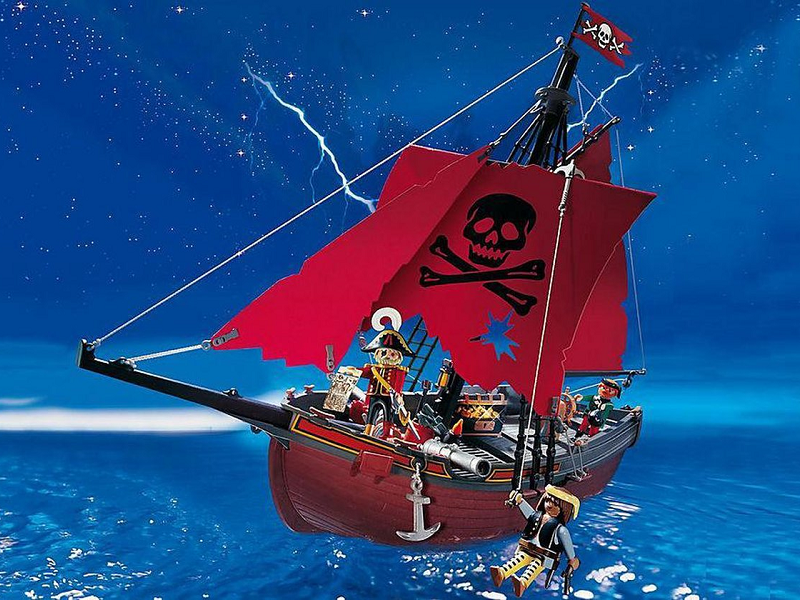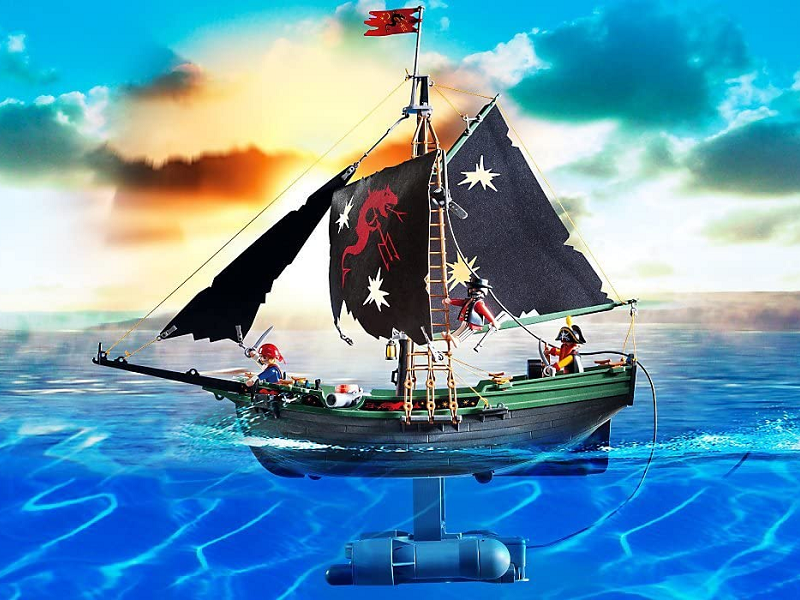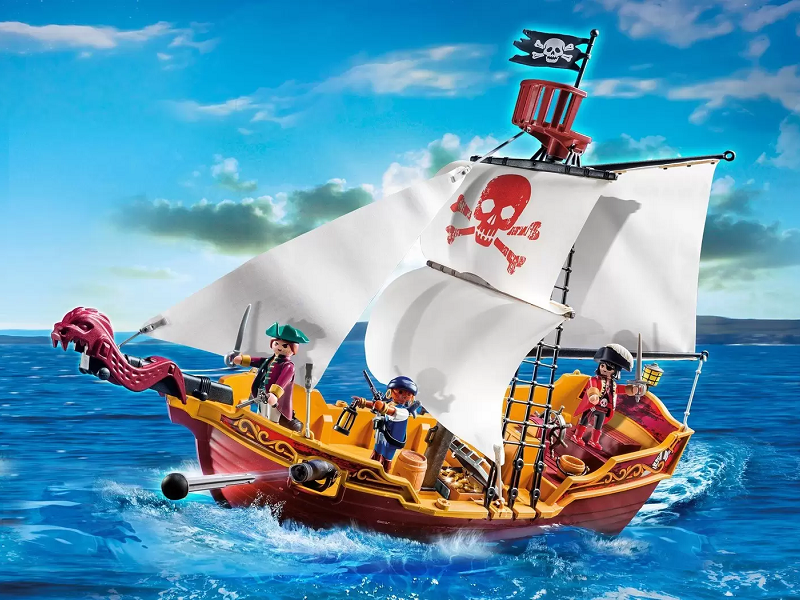Below the scale of those magnificent brigs are four lines of Playmobil sailboats. The first of these to be released wasn’t a pirate vessel at all, but the beautiful Schooner (#3740) in 1991. It was obviously intended as an adversary for the existing pirate ships. Six years later, however, the navy vessel was appropriated by the pirates for the release of the Black Corsair. It was the beginning of a fleet of pirate boats.
Subsequently, with great ingenuity, Playmobil created two further lines based on the same hull mould. The transition is achieved by adding an extra piece to the bow, which includes a bowsprit and therefore facilitates the addition of a jib, and another to the stern, which raises the aftdeck and substitutes the tiller for a wheel. A gaff for a spanker is then added to the single mast. The enlarged sailboat has only ever been used as a navy vessel, in sets #6681/5683, #5140 and #70412.

The final line was the ‘serpent’ sailboat, named after its figurehead. These were a similar size to the Schooner class, but lacked the cargo hold and had neat ports for the cannon to poke through – indicative of a differently designed hull.
These lines are a bit confusing for the realist. A single-masted vessel with one sail is usually referred to as a ‘cat’, while with two sails it is called a ‘sloop’. However, these are invariably fore-and-aft rigged, preferring maneuverability over trade wind induced speed, since they typically work in confined waters. Likewise, although Playmobil have used the term ‘caravel’ (cf. #70412), this refers to a lateen-rigged vessel (sometimes with an additional square-rig on the foremast) unused after the seventeenth-century.
What should we call them then? It’s fair to describe the larger boat (such as the Schooner) and the smaller boats with additional bow, stern and sails, as square-rigged sloops. The unaltered boats have to be regarded as cats, though with some reservation since their sails are a mix of lateen and square-rig.
Incidentally, a ‘schooner’ is also fore-and-aft rigged by definition, and has two or more masts. They may have square-rigged topsails, but that’s all. Beautiful though they are, Playmobil’s ‘schooners’ (such as #3740) are really square-rigged sloops on a different hull – one that allows for a small cargo hold and wheels on the base.
Speaking of hulls, all Playmobil hulls (including those on the brigs) reflect a clinker built construction, that is, with overlapping planks, presumably because it gives a more interesting texture than carvel planking.

The Black Corsair
First released: 1997
Playmobil’s first pirate sloop was released six years after the Schooner on which it was based. Advertised as the ‘Black Corsair’ after its sails and hull, #3860 had a crew of just three to manage the boat and its two cannon, compared with the five fellows on #3740.
The colour scheme on #3860 was playful and, as a result, neither realistic nor attractive. The blue deck with yellow anchor winch and shrouds made it look like a pleasure boat. The mainsail had a sea serpent with trident motif. All the sails had the ragged, cannon-shot blasted look that would characterise the range going forward – in reality, sails left in this condition would quickly tear up in sea winds.
The original klickies were a ginger-bearded captain in a short black cape, a pirate with an eye patch and a boatswain’s hat and an ‘ambiguously brown‘ sailor.
In 1999, the same boat was released as #3029 with an island base and two extra pirates. In 2004, the department store Karstadt sold an identical version (#4067). In 2007, the Black Corsair made a final appearance in set #5775, with a skull and crossbones on the mainsail, and a mortar in place of the cannons. This last mentioned set replaced ‘ambiguous brown’ with a white sailor.
Incidentally, a ‘corsair’ is actually a term for a pirate operating from the Barbary Coast, and not a type of sailboat.

The Red Corsair
First released: 2001
The follow up to the ‘Black Corsair’ was the ‘Red Corsair’ (#3133, #3619 in the USA), also named after the sails and hull. Unusually, the US version came out first; the identical European version was released in 2002. Like the Black Corsair, the Red Corsair has had several reissues and revisions.
In another reverse trend to its predecessor, the Red Corsair was originally available as part of an island set. This was a redcoat base, and so the boat initially came with just two pirates: a grey-bearded captain in an officer’s coat and a ginger-bearded sailor.
In 2003, it was reissued without the island and with a third hand – a klicky with peculiar bumble-bee trousers. This was #3174 (#5733 in the USA). That same set was reissued again in 2009, but as #3900. Finally, in 2010, the boat was issued on its own, with neither crew nor materiel, as #7518.

At the same time as Playmobil were offering #3900 to Europe, North America got #5869. This Red Corsair was the same boat, but with a white skull and crossed swords motif on the sails, and some ghoulish decorative skulls. The crew of three bearded white men were all new pirate klickies.
The colour scheme of the Red Corsair, with its black deck and shrouds, and brown hull, is certainly superior to that of the Black Corsair. The garish and tattered sails with their skull and crossbones motif remained contentious for the collector, however.

Pirate Corsair
Released: 2007
I’ve chosen to list #5810 separately, though it could be considered an updated version of #3860. It couldn’t be called a ‘Black Corsair’ however, since its sails were white. Indeed it was marketed as a ‘Pirate Corsair’, even though that’s tautologous.
Actually it was something of a mash-up on the previous sloops. On the one hand, it had the same hull as the Black Corsair. The white sails, even with their pirate logo and rips, the black shrouds, and the tan brown mast, spars and bowsprit, all went to making this an improvement on the previous blue-black scheme.
On the other hand, it drew its crew from the Red Corsair range. The old captain in his officer’s jacket and the green-shirted, ginger-bearded pirate first appeared in #3619. Here they were joined by a third sailor, a first appearance for that distinctive red, leopard print waistcoat. That klicky, with a new bandana, would reappear in #5378.

Cannon Boat
First released: 2008
In 2008, Playmobil released their first small boat, #4444. It was a lateen-rigged cat with a ragged red sail and a crew of two. Marketed as a ‘Cannon Boat’, it’s actually an ideal vessel for smugglers, navigating their way through coastal waters.
There was an awful lot to like about this set, from the Jolly Roger on the mast which could be lowered and replaced with a French ensign to lure unsuspecting merchantmen into a false sense of security (there was no pirate logo on the sail), to the sideburns and cravat on the red-coated klicky. The deck featured hexagonal standpoints for the crew. An off-white sail featuring running repairs would have been preferable, but this definitely set a standard going forward.
Essentially the same cat would go on to appear in two combination sets, albeit with a black hull, green deck and – in each instance – a different crew. In 2009, it was released in the extraordinary #5009 (#5881 in the USA), which included an island fortified by bluecoat soldiers, the kraken and a shark. In 2015, it came with #5646 alongside another fortified island, this time manned by redcoats.
This last version lost the run-up Jolly Roger and false flag, and the crewman was pulled from the then current Three Pirates set, #6290.

Small Pirate Ship
Released: 2011
That last version of the Cannon Boat with a black hull and green deck was subsequently issued as Playmobil’s first square-rigged cat. As with its predecessors, the new look sailboat was released as part of a combination set with a bluecoat bastion, #5919.
The square sail was white, tattered of course, and featured a large, red pirate motif. Interestingly, the crew on this set were two of the klickies from the Red Corsair, #5869.
A second square-rigged cat was released at the same time as #5919, though this one was a navy vessel, #5948. Manned by bluecoats, it was presumably intended to work as a complement to the soldiers in the fort. Significantly, it had a plain white sail with neither rips nor logo.

Pirate Ship with Underwater Motor
Released: 2013
Playmobil boats can actually float, which is a laudable bit of design work. The underwater motor (#7350) could be added to power it across a pond. The logical next step was a remote control that also works as a ballast: #5238 duly delivered.
This was the last pirate sailboat that Playmobil released based on the Schooner’s hull. The sails reverted to the serpent with trident motif, this time in red on black. The hull was black, the deck green and the shrouds tan brown. It offered a three man crew, all of whom had appeared on previous iterations of the Black Corsair.

Serpent Pirate Boat
Released: 2011
A final version of larger sloop was a neatly-rigged boat with two sails on the main mast. Its distinguishing feature was the dragon-shaped prow, initially red but subsequently brown, that gives the boat its name. The new hull mould featured cut outs for the cannon but no wheels.
The first version (#5950), released in 2011, bucked the trend of garish colour schemes with its black hull and grey deck: the figurehead, shrouds and crow’s nest were red. Its three-man crew were also predominantly red and black. Even the boat’s storage barrels were red. Dare I say, it was a bit dull.
A more varied scheme was adopted for its issue in the USA two years later (#5618) with a chocolate-brown hull and crow’s nest, and butterscotch deck. The crew were also refreshed, with a non-white pirate introduced, and teal, plum and blue clothing offering a welcome splash of colour. This version was released into Europe in 2016 as #5678.
The sails on all three sets were the same: plain white apart from the bright red skull and crossbones on the topsail.
Here’s Jang’s review of #5618:

Skull and Bones Corsair
Released: 2013
Playmobil’s third square-rigged cat was a black-sailed boat with a two man crew, #5298. Released in 2013, it featured a red hull and bronze deck. The sail had no rips, but did feature printed running repairs and a large, white skull and crossed swords motif.
The boat was well-equipped with tools and jewels. The two pirates were original and fiercely armed, one carrying a pair of backswords, while the other had a cutlass and pistol.
The sailboat was made available again in 2018, complete with an underwater motor, in #9522. This set merged the pirate cat with the bluecoat-manned lighthouse that was already available on its own as #6680.
Jang reviewed this one too:

Pirate Boat with Underwater Motor
Released: 2019
The last Playmobil boat to be launched was this lateen-rigged cat with green hull and tan brown deck, #70151. The sail retained its integrity, though the massive skull and crossbones negated the value of the hoistable Jolly Roger.
The crew of three included an ostentatious indigo figure with a cavalier hat and gold boots, and a bearded seadog in a red bandana. For the first time on a pirate boat, it also included a woman. The female figure, however, had already appeared in #9087 a couple of years earlier.
Pirates are by definition waterborne and some sort of ship is therefore essential. As can be seen, over the years Playmobil have offered a good variety of sailboats for their pirates. This is especially true when the brigs are also considered. It’s very easy to put together a flotilla, or to have rival gangs competing for treasure. These are high quality toys that offer enormous playtime potential.
The real advantage of having different lines of sloops and cats is commercial. They offer scaled down versions of the expensive brigs at a more affordable price point. As such, they absolutely have a place in the range, but those with square rigs in particular do not reflect anything historical. What a pity they didn’t ditch the mainsail and jib for a triangular headsail.
EMPM
